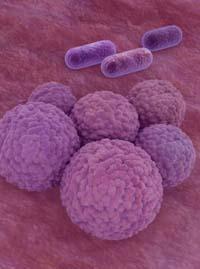Anti-AIDS microbicide, getting closer
2005/12/11 Galarraga Aiestaran, Ana - Elhuyar Zientzia

In fact, a promising research on a microbicide has recently appeared in the scientific journal Nature. This microbicide consists of three main active components, two of which are available to pharmaceutical companies. However, once the results of the research are known, pharmacies have authorized the use of their components.
Researchers had been looking for an effective AIDS microbicide for some time. To avoid sexual transmission, condoms are very effective, but in many places men do not want to use condoms. Consequently, every year thousands of women become infected by unprotected sex.
Replacing condoms with mycobicides would be a good option. Microbicides are vaginal stays, creams, or suppositories that form a protective layer of the virus. That in theory, because so far an effective microbicide against AIDS has not been achieved. Moreover, a single microbicide has been tested in women, with an unfortunate result.
Initially, this microbicide was effective. It had a component that destroys the AIDS virus and worked correctly in the early stages of clinical trials. The last step is to prove in humans and then they saw that instead of benefiting, it hurt. It was toxic at the doses needed to destroy the virus. It damaged vaginal tissue and therefore facilitated entry to the virus.
On three fronts

The microbicide they have presented in N ature magazine is based on a different strategy. Developed by researchers at Cornell University in New York, three active components have been used for the manufacture of the microbicide. Each of these components fights in a front against infection.
For example, a component of the pharmaceutical company Merck has been used, which is associated with the same cell of the vagina where the virus is associated. This leaves the virus with no place. Another component is the pharmacy BMS, which interacts directly with the virus, so it does not allow you to associate it with the cell. Finally, a peptide created by the team of researchers inhibits the process of introducing the virus into the cell.
Researchers tested several combinations in macaques. Some of the combinations allowed macaques to achieve 75% protection. It is not little, but those who tested its three components together improved even more: the three macaques with this combination achieved total protection.
The strategy is similar to that of AIDS patients. They also combine several antiviral drugs and each uses a mechanism to fight the virus.
Driving research

The result has been so satisfying that pharmaceutical companies Merck and BMS have granted authorizations of their components to the entity that will develop the microbicide. Specifically, a non-profit organization will be responsible for the development of the microbicide.
Its intention is to start in 2007 with clinical trials, in which 10,000 African women who calculate between 150 and 200 million dollars will participate. It's not much compared to what you can earn: only in three years, 2.5 million people would save their lives with an effective microbicide before having sex.
Published in 7K.




